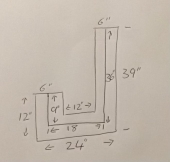


Glenn Herbert wrote:The copper coil will be thin enough that conductivity will not matter much. The water flowing and keeping at least part of it cooler will be more significant. I still don't think it would approach enough absorption to equal up to 9+ m2.
If the ISA is much less than the optimum in the table, it will just not absorb all the heat you have generated and send the rest up the chimney. If your space is that constrained, I would go with a 7" batch box. This will come closer to balancing heat generation and absorption.

Glenn Herbert wrote:I suspect the internal volume you will have in that one thin bell will make it difficult to get enough coil to absorb enough heat from an 8" batch box. A bell in the existing chimney breast space on the upper floor would occupy little room and be much safer than lots of water coil in the first very hot bell.

Glenn Herbert wrote:An 8" batch box is a beast, and while it may well be what you need to heat most of your house, it will need a significantly large ISA to harvest the heat. Otherwise you will just get a very hot exhaust, throwing much of the heat away. Per the sizing table at batchrocket.eu, an 8" system wants 9.4 m2 ISA in the bell.
I don't know if this is possible in your situation, but it has been done to have essentially a two story bell, with the space open through the floor so there can be heated mass at first floor level. Another option would be to have the flue from the lower floor bell feed into a second bell at the upper level.
Fox James wrote:However I do believe there may be sone leeway when building Masonry stoves if they are independently designed and specified by a heating engineer.

thomas rubino wrote:A single bell will share its heat sooner, but will also lose that heat more quickly than a double skin.
thomas rubino wrote:If you have headroom concerns, the roof of your bell can be insulated to limit how hot the bell roof can get.
You should use an insulator between your home and the neighboring house or any outside wall the bell is close to.
thomas rubino wrote:There is a limit to just how much ISA can be maintained hot to keep a steady draw up your chimney.
thomas rubino wrote:Heating an old Victorian house is a big job for any wood burner.
Hopefully, your home is modernized with better insulation and double-pane windows.


thomas rubino wrote:Hi M;
It sounds like you want a simple J-Tube design rocket stove.
Although they can be built with many materials, preferably, you want your core to be built with solid clay bricks.
As you are just building an outdoor trash wood burner and not a mass heater there is plenty of leeway in build parameters.
Dirt is suitable to use in place of clay to fill holes.
The basic dimensions have one requirement. They must keep the same diameter from the feed tube all the way through and up the riser. (chimney)
A Standard 8" rocket stove core has an 8"x8" feed tube that is most commonly made 16" deep.
The horizontal "Burn tunnel" has a "roof length of 10" -12" and is the exact diameter of the feed tube 8x8.
Your riser is also the same diameter 8" and it should be apx 3-4' tall.
If you have 9" material to use then keep it all 9" and you will have no problem.
Cracking is the biggest issue as the rapid heat changes stress most materials.
Solid clay brick will last the longest if true firebrick is not available.
With an open burner like this most anything will burn.
Yes, it will burn painted wood... if you or the neighbors do not mind.
Be very aware that nothing flammable is above your riser(chimney) once lit and gotten up to working temperature, you can have flames showing.

Glenn Herbert wrote:Sounds like a plan

Yes, you can make the firebox from standard old red bricks. Firebricks would last longer, but are not essential for a short-term build. Especially for a short-term build, fireclay slip is probably the best mortar, as it can be knocked off leaving clean bricks when you want to build something new. It may or may not meet building code where you are; it is a bedding/sealing agent only and not a cement. (US "International Building Code" requires refractory cement mortar which is strong and sticks to bricks, though I don't know how often that is actually used.)
It sounds like you have a good tall interior chimney which should have good draft. I hope both houses do not share one flue, as that might cause complications with draft.
Glenn Herbert wrote:No matter where you are, you can probably find bricks, which will be a good material for building a rocket mass heater. Firebricks for the combustion core will last longer, but as this sounds like a short-term setup, you just need to be sure the bricks are not concrete-based, as that will disintegrate in RMH core temperatures. If you are in a remote area and have clay easily accessible, cob is a good reliable material. You can build a complete RMH out of cob - I have done it.
The easiest thing to build would probably be a J-tube inside a masonry bell (hollow brick box). A 6" equivalent size would probably suffice for warming and drying a basement, and is likely the most common chimney vent size to find.